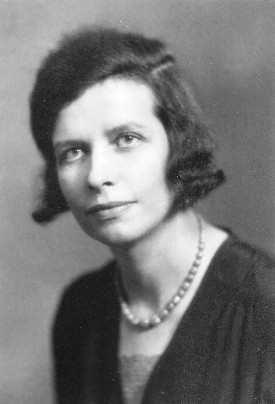
Credited: Dr Alison Hoppen
Anna Buchan
Zoologist & Geologist
1897 - 1964
Anna Buchan was born in Rosehearty, Aberdeenshire. Anna went to Aberdeen University as a mature student, and gained a PhD in zoology. Anna’s thesis is titled Investigation of the Glacial and Postglacial Deposits of Spynie. Her field work was carried out in the old clay pits between what is now the disused railway line, and the road from Elgin to Lossiemouth, near Windyridge. At that time, the pits were in use during the summer, which is when she unearthed the remains used in her paper. The pits were first opened for the working of clay in 1897, and fossils had been found there over the years, including a couple of brittle stars (ELGNM 1978.943c) on display in Elgin Museum, probably donated by one of the Christie family, owners of the Morayshire Brick and Tile Works. No detailed observations were made until Anna’s preliminary investigation in 1931, and her work is cited by JD Peacock, principal author of The Geology of the Elgin District (1968), in a paper in 1999.
Her conclusions on the story of climate and environmental change in the Spynie area are based on study of the stratigraphical and palaeontological evidence from her own observations.
In 1937, when Anna was nearly forty, she married Edward Arthur Suckling, in Glasgow. During the Second World War, Edward was a conscientious objector.
Anna worked as a museum assistant in the Anthropological Museum, Marischal College, Aberdeen University from 1946–48. An illustrated article under her married name is published in the Aberdeen University Review of Summer 1947, entitled ‘Lamps Through the Ages’. Some 200 lamps from around the world had been donated to the Museum by George Johnston, of a family of paper makers. Anna judged the most remarkable historically to be a red clay lamp dated to about 4777BC, when Egypt was ruled by Mena, its first king. Researching the collection was probably the stimulus for writing this broader article about the history of artificial lighting, in which she also describes the development of the Scottish cruisie.
Her mother, also Anna, died in Dr Gray’s Hospital in 1948, and Anna moved back to Elgin to look after her widowed father. Her husband opened a hairdresser’s business at 22 South Street. He was also pastor of the Apostolic Church at 31 Academy Street.
Anna was active in Elgin Museum from at least 1948, perhaps even before she left the Marischal.
Later in 1949, Anna became a director of the Moray Literary and Scientific Society, and in 1951, she was appointed honorary joint curator with WE Watson, of the wood and sawmills in Elgin. Again Anna was at work on the internationally important geology collection and is recorded as cleaning, reviewing and rearranging the specimens in the store and on display. Watson resigned in 1952 and died soon after, and Anna was then sole curator, until she resigned the following year. Her father died in 1954, aged eighty-four. In 1961, Anna was again appointed to a post in the museum, as museum keeper, but she withdrew the same day in favour of her friend Miss AC Kennedy. Within Elgin Museum, Anna is remembered in the alcove ‘Where are the Women of History?’ in the People and Place exhibition about the past 1,000 years of life in Moray. Anna was widowed in 1963. She died the following year at the age of sixty-six in Foresterhill Hospital, Aberdeen, from bacterial endocarditis, having had no previous heart problem. Just before she died ‘she was as usual solicitous of other members of the family’.
The headline of her obituary in The Elgin Courant reads ‘was widow of an Elgin hairdresser’, confirming that this influential woman’s achievements were and have been sadly neglected.
Our Thanks to http://www.womenofmoray.org.uk for their help with this information
To make your own nomination download the nomination form here